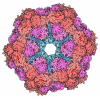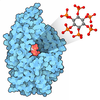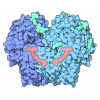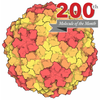+ Open data
Open data
- Basic information
Basic information
| Entry |  | |||||||||
|---|---|---|---|---|---|---|---|---|---|---|
| Title | WEEV McMillan VLP in complex with VLDLR LA(1-2) | |||||||||
 Map data Map data | ||||||||||
 Sample Sample |
| |||||||||
 Keywords Keywords | Alphavirus Receptor / VIRUS / VIRAL PROTEIN | |||||||||
| Function / homology |  Function and homology information Function and homology informationreelin receptor activity / VLDL clearance / glycoprotein transport / very-low-density lipoprotein particle receptor activity / ventral spinal cord development / Reelin signalling pathway / very-low-density lipoprotein particle binding / low-density lipoprotein particle receptor activity / very-low-density lipoprotein particle clearance / togavirin ...reelin receptor activity / VLDL clearance / glycoprotein transport / very-low-density lipoprotein particle receptor activity / ventral spinal cord development / Reelin signalling pathway / very-low-density lipoprotein particle binding / low-density lipoprotein particle receptor activity / very-low-density lipoprotein particle clearance / togavirin / reelin-mediated signaling pathway / very-low-density lipoprotein particle / positive regulation of dendrite development / cargo receptor activity / T=4 icosahedral viral capsid / lipid transport / dendrite morphogenesis / regulation of synapse assembly / apolipoprotein binding / cholesterol metabolic process / clathrin-coated pit / receptor-mediated endocytosis / VLDLR internalisation and degradation / memory / calcium-dependent protein binding / nervous system development / symbiont-mediated suppression of host toll-like receptor signaling pathway / host cell cytoplasm / receptor complex / symbiont-mediated suppression of host gene expression / lysosomal membrane / serine-type endopeptidase activity / fusion of virus membrane with host endosome membrane / calcium ion binding / symbiont entry into host cell / virion attachment to host cell / host cell nucleus / host cell plasma membrane / glutamatergic synapse / virion membrane / structural molecule activity / signal transduction / proteolysis / RNA binding / membrane / plasma membrane Similarity search - Function | |||||||||
| Biological species |  Western equine encephalitis virus / Western equine encephalitis virus /  Homo sapiens (human) Homo sapiens (human) | |||||||||
| Method | single particle reconstruction / cryo EM / Resolution: 3.96 Å | |||||||||
 Authors Authors | Raju S / Diamond MS / Fremont DH / Center for Structural Biology of Infectious Diseases (CSBID) | |||||||||
| Funding support |  United States, 1 items United States, 1 items
| |||||||||
 Citation Citation |  Journal: Cell / Year: 2025 Journal: Cell / Year: 2025Title: Structural basis for plasticity in receptor engagement by an encephalitic alphavirus. Authors: Saravanan Raju / Sathvik Palakurty / Alan Sariol / Ngan Wagoner / Lucas J Adams / Sean Hui / William B Klimstra / Daved H Fremont / Michael S Diamond /  Abstract: The structural basis for shifts in receptor usage remains poorly understood despite the implications for virus adaptation and emergence. Western equine encephalitis virus (WEEV) strains exhibit ...The structural basis for shifts in receptor usage remains poorly understood despite the implications for virus adaptation and emergence. Western equine encephalitis virus (WEEV) strains exhibit different patterns of engagement for two of their entry receptors: very-low-density lipoprotein receptor (VLDLR) and protocadherin 10 (PCDH10). Using structural and functional studies, we show that while all WEEV strains have a lipoprotein class A (LA) domain binding site near the E1 fusion loop, VLDLR engagement requires a second binding site in E2 that can vary with single nucleotide substitutions. We also resolve a structure of PCDH10 bound to WEEV, which reveals interactions near the E1 fusion loop with residues that also mediate LA domain binding. Evolutionary analysis enabled the generation of a PCDH10 decoy that protects in vivo against all WEEV strains tested. Our experiments demonstrate how viruses can engage multiple receptors using shared determinants, which likely impacts cellular tropism and virulence. | |||||||||
| History |
|
- Structure visualization
Structure visualization
| Supplemental images |
|---|
- Downloads & links
Downloads & links
-EMDB archive
| Map data |  emd_47821.map.gz emd_47821.map.gz | 97.1 MB |  EMDB map data format EMDB map data format | |
|---|---|---|---|---|
| Header (meta data) |  emd-47821-v30.xml emd-47821-v30.xml emd-47821.xml emd-47821.xml | 22 KB 22 KB | Display Display |  EMDB header EMDB header |
| FSC (resolution estimation) |  emd_47821_fsc.xml emd_47821_fsc.xml | 9.9 KB | Display |  FSC data file FSC data file |
| Images |  emd_47821.png emd_47821.png | 64 KB | ||
| Filedesc metadata |  emd-47821.cif.gz emd-47821.cif.gz | 6.7 KB | ||
| Others |  emd_47821_half_map_1.map.gz emd_47821_half_map_1.map.gz emd_47821_half_map_2.map.gz emd_47821_half_map_2.map.gz | 95.4 MB 95.4 MB | ||
| Archive directory |  http://ftp.pdbj.org/pub/emdb/structures/EMD-47821 http://ftp.pdbj.org/pub/emdb/structures/EMD-47821 ftp://ftp.pdbj.org/pub/emdb/structures/EMD-47821 ftp://ftp.pdbj.org/pub/emdb/structures/EMD-47821 | HTTPS FTP |
-Validation report
| Summary document |  emd_47821_validation.pdf.gz emd_47821_validation.pdf.gz | 1.1 MB | Display |  EMDB validaton report EMDB validaton report |
|---|---|---|---|---|
| Full document |  emd_47821_full_validation.pdf.gz emd_47821_full_validation.pdf.gz | 1.1 MB | Display | |
| Data in XML |  emd_47821_validation.xml.gz emd_47821_validation.xml.gz | 18.5 KB | Display | |
| Data in CIF |  emd_47821_validation.cif.gz emd_47821_validation.cif.gz | 23.7 KB | Display | |
| Arichive directory |  https://ftp.pdbj.org/pub/emdb/validation_reports/EMD-47821 https://ftp.pdbj.org/pub/emdb/validation_reports/EMD-47821 ftp://ftp.pdbj.org/pub/emdb/validation_reports/EMD-47821 ftp://ftp.pdbj.org/pub/emdb/validation_reports/EMD-47821 | HTTPS FTP |
-Related structure data
| Related structure data |  9e9yMC  9e96C  9e9zC  9eauC M: atomic model generated by this map C: citing same article ( |
|---|---|
| Similar structure data | Similarity search - Function & homology  F&H Search F&H Search |
- Links
Links
| EMDB pages |  EMDB (EBI/PDBe) / EMDB (EBI/PDBe) /  EMDataResource EMDataResource |
|---|---|
| Related items in Molecule of the Month |
- Map
Map
| File |  Download / File: emd_47821.map.gz / Format: CCP4 / Size: 103 MB / Type: IMAGE STORED AS FLOATING POINT NUMBER (4 BYTES) Download / File: emd_47821.map.gz / Format: CCP4 / Size: 103 MB / Type: IMAGE STORED AS FLOATING POINT NUMBER (4 BYTES) | ||||||||||||||||||||||||||||||||||||
|---|---|---|---|---|---|---|---|---|---|---|---|---|---|---|---|---|---|---|---|---|---|---|---|---|---|---|---|---|---|---|---|---|---|---|---|---|---|
| Projections & slices | Image control
Images are generated by Spider. | ||||||||||||||||||||||||||||||||||||
| Voxel size | X=Y=Z: 1.081 Å | ||||||||||||||||||||||||||||||||||||
| Density |
| ||||||||||||||||||||||||||||||||||||
| Symmetry | Space group: 1 | ||||||||||||||||||||||||||||||||||||
| Details | EMDB XML:
|
-Supplemental data
-Half map: #1
| File | emd_47821_half_map_1.map | ||||||||||||
|---|---|---|---|---|---|---|---|---|---|---|---|---|---|
| Projections & Slices |
| ||||||||||||
| Density Histograms |
-Half map: #2
| File | emd_47821_half_map_2.map | ||||||||||||
|---|---|---|---|---|---|---|---|---|---|---|---|---|---|
| Projections & Slices |
| ||||||||||||
| Density Histograms |
- Sample components
Sample components
-Entire : Western equine encephalitis virus
| Entire | Name:  Western equine encephalitis virus Western equine encephalitis virus |
|---|---|
| Components |
|
-Supramolecule #1: Western equine encephalitis virus
| Supramolecule | Name: Western equine encephalitis virus / type: virus / ID: 1 / Parent: 0 / Macromolecule list: #1-#4 / NCBI-ID: 11039 / Sci species name: Western equine encephalitis virus / Virus type: VIRUS-LIKE PARTICLE / Virus isolate: STRAIN / Virus enveloped: Yes / Virus empty: No |
|---|
-Macromolecule #1: Spike glycoprotein E1
| Macromolecule | Name: Spike glycoprotein E1 / type: protein_or_peptide / ID: 1 / Number of copies: 4 / Enantiomer: LEVO |
|---|---|
| Source (natural) | Organism:  Western equine encephalitis virus / Strain: McMillan Western equine encephalitis virus / Strain: McMillan |
| Molecular weight | Theoretical: 47.36882 KDa |
| Recombinant expression | Organism:  Homo sapiens (human) Homo sapiens (human) |
| Sequence | String: FEHATTVPNV PGIPYKALVE RAGYAPLNLE ITVVSSELTP STNKEYVTCR FHTVIPSPQV KCCGSLECKA SSKADYTCRV FGGVYPFMW GGAQCFCDSE NTQLSEAYVE FAPDCTIDHA VALKVHTAAL KVGLRIVYGN TTAHLDTFVN GVTPGSSRDL K VIAGPISA ...String: FEHATTVPNV PGIPYKALVE RAGYAPLNLE ITVVSSELTP STNKEYVTCR FHTVIPSPQV KCCGSLECKA SSKADYTCRV FGGVYPFMW GGAQCFCDSE NTQLSEAYVE FAPDCTIDHA VALKVHTAAL KVGLRIVYGN TTAHLDTFVN GVTPGSSRDL K VIAGPISA AFSPFDHKVV IRKGLVYNYD FPEYGAMKPG AFGDIQASSL DATDIVARTD IRLLKPSVKN IHVPYTQAVS GY EMWKNNS GRPLQETAPF GCKIEVEPLR ASNCAYGHIP ISIDIPDAAF VRSSESPTIL EVSCTVADCI YSADFGGSLT LQY KADREG HCPVHSHSTT AVLKEATTHV TAVGSITLHF STSSPQANFI VSLCGKKTTC NAECKPPADH IIGEPHKVDQ EFQA AVSKT SWNWLLALFG GASSLIVVGL IVLVCSSMLI NTRR UniProtKB: Structural polyprotein |
-Macromolecule #2: Structural polyprotein
| Macromolecule | Name: Structural polyprotein / type: protein_or_peptide / ID: 2 / Number of copies: 4 / Enantiomer: LEVO |
|---|---|
| Source (natural) | Organism:  Western equine encephalitis virus / Strain: McMillan Western equine encephalitis virus / Strain: McMillan |
| Molecular weight | Theoretical: 45.357879 KDa |
| Recombinant expression | Organism:  Homo sapiens (human) Homo sapiens (human) |
| Sequence | String: PYLGFCPYCR HSAPCFSPIK IENVWDESDD GSIRIQVSAQ FGYNQAGTAD VTKFRYMSYD HDHDIKEDSM EKIAISTSGP CRRLGHKGY FLLAQCPPGD SVTVSITSGA SENSCTVEKK IRRKFVGREE YLFPPVQGKL VKCHVYDRLK ETSAGYITMH R PGPHAYKS ...String: PYLGFCPYCR HSAPCFSPIK IENVWDESDD GSIRIQVSAQ FGYNQAGTAD VTKFRYMSYD HDHDIKEDSM EKIAISTSGP CRRLGHKGY FLLAQCPPGD SVTVSITSGA SENSCTVEKK IRRKFVGREE YLFPPVQGKL VKCHVYDRLK ETSAGYITMH R PGPHAYKS YLKEASGEVY IKPPSGKNVT YECKCGDYST GIVSTQTKMN GCTKARQCIA YKLDQTKWVF NSPDLIRHTD HS VQGKLHI PFRLTPTVCP VPLAHTPTVT KWFKGITLHL TATRPTLLTT RKLGLRADAT AEWITGTTSR NFSVGREGLE YVW GNHEPV RVWAQESAPG DPHGWPHEII IHYYHRHPVY TVIVLCGVAL AILVGTASSA ACIAKARRDC LTPYALAPNA TVPT ALAVL CCI UniProtKB: Structural polyprotein |
-Macromolecule #3: Capsid protein
| Macromolecule | Name: Capsid protein / type: protein_or_peptide / ID: 3 / Number of copies: 4 / Enantiomer: LEVO / EC number: togavirin |
|---|---|
| Source (natural) | Organism:  Western equine encephalitis virus Western equine encephalitis virus |
| Molecular weight | Theoretical: 16.712816 KDa |
| Recombinant expression | Organism:  Homo sapiens (human) Homo sapiens (human) |
| Sequence | String: ESDKTFPIML NGQVNGYACV VGGRLMKPLH VEGKIDNEQL AAVKLKKASM YDLEYGDVPQ NMKSDTLQYT SDKPPGFYNW HHGAVQYEN GRFTVPRGVG GKGDSGRPIL DNRGRVVAIV LGGANEGTRT ALSVVTWNQK GVTIKDTPEG SEPW UniProtKB: Structural polyprotein |
-Macromolecule #4: Very low-density lipoprotein receptor
| Macromolecule | Name: Very low-density lipoprotein receptor / type: protein_or_peptide / ID: 4 / Number of copies: 4 / Enantiomer: LEVO |
|---|---|
| Source (natural) | Organism:  Homo sapiens (human) Homo sapiens (human) |
| Molecular weight | Theoretical: 8.58535 KDa |
| Recombinant expression | Organism:  Homo sapiens (human) Homo sapiens (human) |
| Sequence | String: AKCEPSQFQC TNGRCITLLW KCDGDEDCVD GSDEKNCVKK TCAESDFVCN NGQCVPSRWK CDGDPDCEDG SDESPEQC UniProtKB: Very low-density lipoprotein receptor |
-Macromolecule #5: CALCIUM ION
| Macromolecule | Name: CALCIUM ION / type: ligand / ID: 5 / Number of copies: 8 / Formula: CA |
|---|---|
| Molecular weight | Theoretical: 40.078 Da |
-Experimental details
-Structure determination
| Method | cryo EM |
|---|---|
 Processing Processing | single particle reconstruction |
| Aggregation state | particle |
- Sample preparation
Sample preparation
| Buffer | pH: 7.4 |
|---|---|
| Vitrification | Cryogen name: ETHANE |
- Electron microscopy
Electron microscopy
| Microscope | TFS KRIOS |
|---|---|
| Image recording | Film or detector model: FEI FALCON IV (4k x 4k) / Average electron dose: 45.0 e/Å2 |
| Electron beam | Acceleration voltage: 300 kV / Electron source:  FIELD EMISSION GUN FIELD EMISSION GUN |
| Electron optics | Illumination mode: FLOOD BEAM / Imaging mode: BRIGHT FIELD / Nominal defocus max: 2.2 µm / Nominal defocus min: 0.7000000000000001 µm |
| Experimental equipment |  Model: Titan Krios / Image courtesy: FEI Company |
 Movie
Movie Controller
Controller




















 Z (Sec.)
Z (Sec.) Y (Row.)
Y (Row.) X (Col.)
X (Col.)





































